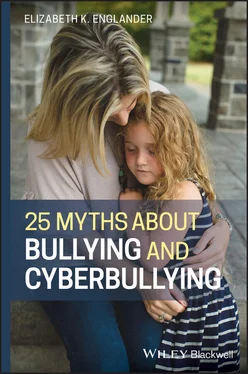Maybe your kids have been bullied, or maybe you worry that they will be. Bullying today still happens, at times, in a more traditional way: for example, a little boy could be bullied on the playground by a slightly older boy. It can also happen in new and confounding ways: perhaps a teenage girl discovers that a topless photo, sent privately to a date, has been distributed around the school, and the result is a social crisis for her. What you read, see, and hear about bullying may feel familiar, or it may feel utterly alien. The fact is, bullying is a social problem that has remained the same, but it's also gone through a monumental metamorphosis. Back in the early 1990s, the violence‐prevention focus was almost entirely on boys and gang violence, and with good reason: America was in the midst of a terrible violent crime wave, and Americans were enduring a daily onslaught of bad news about violent males. In 1995, a Princeton professor, John DiIulio, even coined the term superpredator to describe what he envisioned as a looming generation of totally callous and aggressive male criminals. 1 Few researchers, if any, anticipated the dramatic drop in traditional violent crime that was about to occur, or the emergence of bullying and cyberbullying as key concerns.
The result is that today, you can scarcely watch a newscast or read a newsfeed without seeing a story about bullying or cyberbullying. The troubles spattered across our media today aren't only new; they're newly confounding. Kids who bully a schoolmate who's disabled, mocking him or her. Schools that ban cell phones, only to find that kids continue to text each other on their Fitbits. New and baffling problems, articles, opinions, and advice abound. Yet even this large (indeed, sometimes overwhelming) flood of information doesn't provide many answers about what to believe (is cyberbullying really rampant?), how to tell when something is truly a problem (my son seems OK with the apparently abusive talk that takes place during online video games), or what parents are supposed to actually do (or not do, as the case may be). Should you try to force your reluctant child to talk about a bullying situation? Will taking away their cell phone make the situation worse or better? The schools say “Tell us everything,” but your child begs for confidentiality – now what? How do you help your son or daughter learn to properly use digital devices when they're the expert and you're the pupil? How can you make your child less vulnerable – more self‐confident, more popular? The school tells you that your child bullied someone, but your child says they're the victim. The other kid's parents say it was a fight. Now what?
Ironically, the high level of interest that surrounds these problems could easily raise the sneaking suspicion that bullying is just the currently fashionable psychobabble rather than a genuine predicament. There's a kernel of truth to that. It does seem as though the word bullying is applied to almost any situation where someone's feelings are hurt. In a 2018 study of more than 600 teens, I found that 62% of the kids who believed they were “bullied” were actually using the word to describe different problems, such as fights with friends. And like all fashionable disorders, bullying may be less common than we think. For a few years now, a number of surveys have found reductions in the rate of bullying, rather than increases. One study of 27 countries in Europe and North America found that most countries are reporting less bullying. England, Norway, Australia, Spain, and the United States have all found that traditional bullying is becoming less common. All this sounds like good news, yet these reassurances can still ring hollow. Even one case is too many if it's causing real misery, and statistics are cold comfort to those who suffer under bullying or who are forced to watch their children suffer.
Furthermore, regardless of the overall trends, contemporary forms of bullying and cyberbullying remain unsettling. You may have been left out of a party back in the third grade, but it's hard to imagine the impact on your daughter when a topless photo of her gets passed around an entire high school. One of the most difficult things about being a parent today isn't social cruelty per se, but the yawning gap in knowledge (particularly around digital issues) and a display of unmistakable human cruelty that is disquieting. Decreasing or increasing, the fact is that bullying and cyberbullying remain among the most commonly cited concerns expressed by parents and educators. A national poll of parents in 2017 2 found that bullying and cyberbullying were a number‐one concern. Let's be clear: exaggerating dangers is destructive, since it can unnecessarily raise anxiety. But it's equally pointless to ignore real social problems, regardless of whether they are more common, less common, fundamentally new and different, or a rehashing of old conflicts and abuses. The key, I think, is figuring out how to separate the myths from the facts – and thereby identify the real problems.
Internationally, there's no paucity of efforts to prevent bullying and cyberbullying. Significant resources have been mobilized; and as of this writing, Canada, Britain, Australia, and almost every state in the United States have passed laws that seek to address these behaviors. 3 The European Commission has been working with social networking companies since 2009 to reduce online bullying risks. A casual search on the Internet reveals a veritable avalanche of resources to prevent bullying and cyberbullying – everything from Assertiveness Training to Zen Buddhism.
Yet even with all this attention, these difficulties stubbornly persist, in large part due to their fast‐changing, emotional, and profoundly complex nature. The advice lags far behind the actual knowledge. Understanding what causes, stops, and is important about bullying and cyberbullying hasn't been made much easier by an Internet teeming with well‐intentioned guidance. Googling the phrase “bullying because of a nude picture” in an attempt to help your teenage daughter cope yields a mind‐bending 12.5 million websites. It's the largest library in the world, with heaps and piles of books stacked as high as a building but in no particular order. If you're looking for help with bullying and cyberbullying on the Internet, that's what you're up against. Sometimes new problems are difficult to handle because we don't have enough information; at other times they're difficult because we have too much information, and the information is hard to find, inaccessible, or the wrong type. The data are disorganized, and large segments are outdated. And not all bullying is alike. If you're looking for advice on how to handle bullying between middle school boys while playing a video game, you might find yourself reading recommendations about how to handle third‐grade boys on the playground, or advice on how to avoid fights in the cafeteria between teenage boys.
Even if you do find information about exactly the type of issue you're concerned about, the sheer volume of opinions and advice can throw up yet another roadblock. Let's imagine a scenario in which your fourth‐grade daughter is being targeted at school and online because she didn't invite a popular girl to her birthday party. Different sources of advice might offer wildly contradictory recommendations. Your daughter should tell school personnel so they can support her; or she should not tell, lest they decide she's a whiner and her friends label her a tattle. Her friends should stick by her, but maybe it's a friend who's targeting her. She should ignore the bully, or, alternatively, assertively tell the bully how she feels. How does she react online, and should that be different from how she responds at school? One resource may recommend keeping any messages or postings as evidence; another may suggest that they should be ignored and immediately deleted. And while traditionally most parents would go back to their own father or mother for parenting advice, you can't do that for these new types of problems. That means you've lost a major source of parenting support.
Читать дальше












